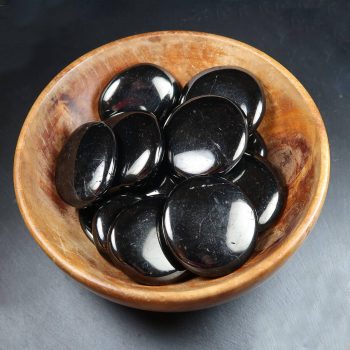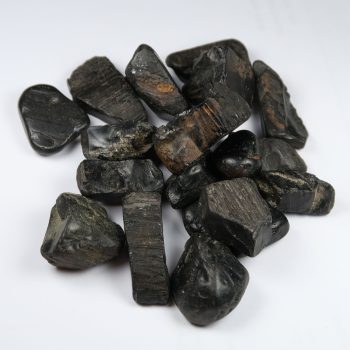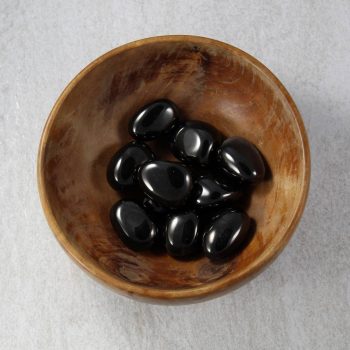Jet
Whitby Jet, perhaps unsurprisingly, is found in Whitby – North Yorkshire, UK. It is a form of petrified wood specific to the area, coming from buried Monkey Puzzle trees. Jet has been used by jewellers for centuries – including some finds of Anglo Saxon / Anglo Scandinavian origins. It soared into popularity during the reign of Queen Victoria, particularly as mourning jewellery.
It is a relatively soft stone, which is perfect for jewellery making, and takes a fine polish.
There are still numerous excellent jet works in Whitby today producing jewellery, and many beach combers hunt the beaches around the area looking for small pieces. It is worth noting, however, there are two distinct ‘types’ of Jet found in Whitby, usually referred to as ‘soft’ and ‘hard’ – the soft material being less likely to hold fine details when carved.
There are other locales for Jet around the world, including pieces being sold as French Jet, or Anthracite Jet.
Showing all 3 results
-

Jet Palmstones
Price range: £4.00 through £5.00 -

Jet Specimens / Rough (Whitby, UK)
Price range: £2.00 through £5.00 -

Jet Tumblestones
Price range: £2.00 through £2.50
Appearance, Uses and History
Jet is a type of Lignite, otherwise known as Brown Coal.
It is usually either a very dark brown or black, and is formed by decomposing wood from millions of years ago.
As trees naturally fell, they washed down rivers into the sea, where they sank. They were buried under layers of sediment, sand, stone and other materials over the years, and slowly compressed into Jet – similar to the formation of Coal.
Uses
Jet is pretty much exclusively used as a gemstone, or as a mineral sample for collectors.
The main use is for jewellery, as it has been throughout history. It is also sold carved and polished, as it is very easy to work with.
History and Name
This material has been used for ornamentation since antiquity.
The name ‘Jet’ comes from the French ‘Jaiet’, which came from Latin – which came from Ancient Greek!
The term ‘jet black’ derives from this lovely black material, too.
It was widely used for decorative jewellery by the Romans and the Vikings. It later came back into popularity with the Victorian age, when it was used for mourning jewellery. Jet has been carved for at least 10000 years; so this certainly isn’t a complete list!
In the modern day, Jet is primarily used for jewellery, and is popular with the gothic subculture – a large Gothic festival happens in Whitby every year.
Locales
Jet is found in several places around the world. By far and away the most famous is Whitby, UK. It can also be found in Mongolia, Poland, Portugal, Russia, Spain, Tibet, and Turkey. I’m sure this is not an exhaustive list!
However, Whitby Jet is unique; this can cause some confusion and disagreements over using the term “Jet”.
Mineralogy
The streak of these pieces should, ideally, be a light gingery brown. Obviously, make sure to use white ceramic streak plates.
Hazards and Warnings
Almost all rocks, minerals (and, frankly, almost all other substances on earth) can produce toxic dust when cutting, which can cause serious respiratory conditions including silicosis.
When cutting or polishing rocks, minerals, shells, etc, all work should be done wet to minimise the dust, and a suitable respirator or extraction system should be used.
Burning Lignite can cause pollution; but we don’t recommend that anyway…
Translations
Translations are done via Google translate, and I suspect they will be inaccurate due to more common uses of the word jet; so I have left this mostly blank. Some translations were available but may be “jet stone” or “lignite”.
Arabic:
- فحم بني
Hindi:
Portuguese:
Bengali:
Indonesian:
Punjabi:
English:
- jet
- lignite
- ‘black amber’ (inaccurate)
Italian:
Russian:
French:
- jais
Japanese:
Spanish:
- Azabache
German:
- Gagat
Korean:
Thai:
Gujurati:
Mandarin and Traditional Chinese:
Urdu:
